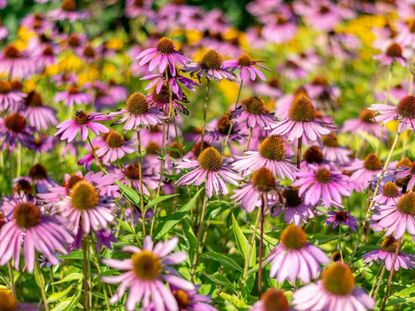Best Landscape Plants For The Upper Midwest Region


Landscape plants in Minnesota, Wisconsin, Iowa, and Michigan are plentiful. Choosing the best shrubs, trees, and perennials can be overwhelming. Here are some of the best options for upper Midwest gardens based on attractiveness, ease of maintenance and appropriateness for the climate.
Trees
Among the most foundational Michigan, Iowa, Wisconsin, and Minnesota plants for landscaping are trees. Start with a few strategically placed trees and build your garden around them.
River Birch
This smaller accent tree provides visual interest year-round with its flaky white bark. River birch tolerates wet soil that doesn’t drain well.
Northern Catalpa
This is a great urban tree that tolerates many types of soil. Catalpa produces large green leaves, fragrant white flowers, and long seed pods.
Serviceberry
Another good flowering tree for Midwest states, serviceberry is small, produces edible berries, and has good fall color.
Hackberry
This shade tree is underutilized in the home garden. Hackberry grows about 60 feet (18 m) tall with an equal spread. It also feeds native birds.
Kentucky Coffeetree
Despite the name, this tree does grow well in all upper Midwest states. Kentucky Coffeetree is a tall shade tree that tolerates winter salt spray. Choose a male tree to avoid messy seed pods.
Gardening tips, videos, info and more delivered right to your inbox!
Sign up for the Gardening Know How newsletter today and receive a free download of our most popular eBook "How to Grow Delicious Tomatoes."
Concolor Fir
This attractive evergreen looks similar to blue spruce but is not susceptible to needlecast, a fungal disease. Concolor firs grow up to 50 feet (15 m) tall.
Shrubs
Also important in Iowa, Michigan, Minnesota, and Wisconsin plants in the landscape are shrubs. Lower than trees, they offer opportunities to create focal points, hedges and borders and visual interest.
Serviceberry
Serviceberry makes the list again because you can find shrub varieties with the same edible berries and spring flowers. The tree grows about 25 feet (7.6 m) tall and the shrub six feet (1.8 m).
Common Ninebark
This medium-sized shrub can grow in a variety of tough conditions and soil types. Ninebark produces flowers in spring and berries that attract birds in fall.
Winterberry
Winterberry is a native holly and a great choice for winter color. To get the most berries, be sure you choose a male shrub.
Common Lilac
Although not native, lilac is also not invasive in the Midwest. It is very popular in landscaping for the beautifully-scented spring flowers. Even when not in bloom, lilac is an attractive deciduous shrub you can prune and shape or leave alone to grow large.
Red Chokeberry
This medium, multi-stemmed shrub has something for every season: white spring flowers, green summer foliage, orange to purple-red fall foliage, fall berries, and reddish winter bark.
Perennials
For Midwest flowers, perennials are a great choice. Annuals are nice too, but perennial varieties require less care and will come back year after year.
Butterfly Weed
This is a low maintenance flower for full sun that attracts pollinators with its cheerful clusters of orange flowers. A type of milkweed, butterfly weed is a host plant for monarch butterflies.
Coneflower
Also known as echinacea, coneflower is a tall, tough perennial that is vey easy to grow. Most often seen in purple, you can now find other color forms, like red, orange, and white.
Balloon Flower
This is a lower growing perennial that stays less than about 1.5 feet (0.45 m) tall. Balloon flower is low maintenance and produces striking, star-shaped flowers throughout summer.
Bleeding Heart
For shadier areas, and for a plant that is deer-resistant, choose bleeding heart. The unique flowers are heart shaped with a petal that hangs below, giving this plant its name. They come in pink and white varieties.
Hosta
Hostas are not native to the region, but they are extremely popular in the perennial garden. Hostas come in a wide variety of sizes and foliage colors, are easy to grow, and tolerate shade very well.
For the best Michigan, Minnesota, Wisconsin, and Iowa plants in the landscape, consider these options, and also choose native species whenever possible. Native east north central plants support pollinators and wildlife and also require fewer resources.

Mary Ellen Ellis has been gardening for over 20 years. With degrees in Chemistry and Biology, Mary Ellen's specialties are flowers, native plants, and herbs.